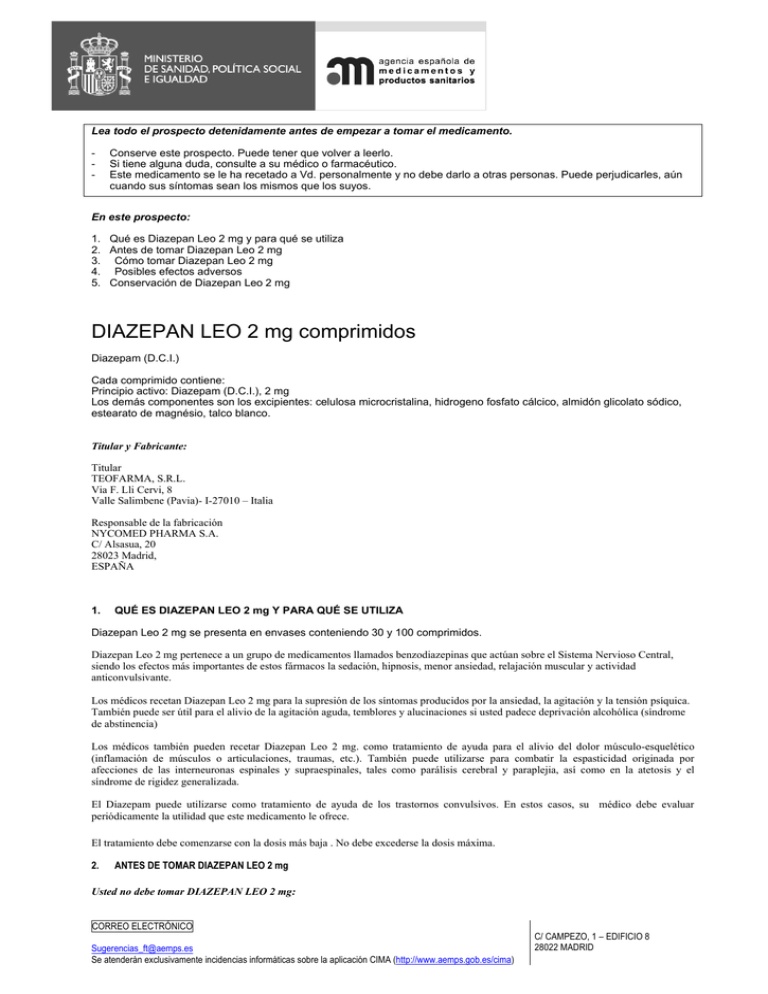

DIAZEPAN LEO 2 mg TABLETS

Ask a doctor about a prescription for DIAZEPAN LEO 2 mg TABLETS

How to use DIAZEPAN LEO 2 mg TABLETS
Introduction
Package Leaflet: Information for the User
Diazepan Leo 2 mg Tablets
Diazepam
Read this package leaflet carefully before you start taking this medicine, because it contains important information for you.
- Keep this package leaflet, you may need to read it again.
- If you have any further questions, ask your doctor or pharmacist.
- This medicine has been prescribed for you only. Do not pass it on to others. It may harm them, even if their symptoms are the same as yours.
- If you experience any side effects, talk to your doctor or pharmacist, even if they are not listed in this package leaflet. See section 4.
Contents of the Package Leaflet:
- What is Diazepan Leo and what is it used for
- What you need to know before taking Diazepan Leo
- How to take Diazepan Leo
- Possible side effects
- Storage of Diazepan Leo
- Contents of the pack and further information
1. What is Diazepan Leo and what is it used for
This medicine contains the active substance diazepam, which belongs to a group of medicines called benzodiazepines.
Diazepam has a calming effect, sedative, muscle relaxant, and anticonvulsant effects.
Doctors prescribe this medicine to people who have symptoms of anxiety, agitation, and mental tension caused by psychoneurotic states and transient situational disorders. Benzodiazepines are only indicated for the treatment of intense disorders that limit activity or subject the person to significant stress.
It may also be useful for relieving symptoms of acute agitation, tremors, and hallucinations in patients with alcohol withdrawal syndrome.
This medicine contributes to the relief of muscle pain caused by muscle spasms or inflammation of muscles or joints, trauma, etc. It can also be used to combat spasms caused by diseases such as cerebral palsy (a group of disorders that affect a person's ability to move, balance, and posture) and paraplegia (paralysis of the lower half of the body, affecting both legs), as well as in athetosis (continuous, involuntary, slow, and extravagant movements of fingers and hands) and in the stiff person syndrome.
This medicine may be used as an adjunctive treatment (treatment given after the main treatment to increase the chances of a cure) for convulsive disorders (such as epilepsy, convulsions), but it has not been shown to be useful as a single treatment. In these cases, your doctor will periodically assess the usefulness of the medicine for your case.
2. What you need to know before taking Diazepan Leo
Do not take Diazepan Leo
- If you are allergic to the active substance or any of the other ingredients of this medicine (listed in section 6).
- If you are allergic (hypersensitive) to other medicines in the benzodiazepine group.
- If you have breathing difficulties related or not to sleepfor a long time.
- If you have a disease called "myasthenia gravis", which is characterized by muscle weakness and fatigue
- If you have severe respiratory problems (severe respiratory failure).
- If you have severe liver problems (severe liver failure).
- If you are dependent on drugs or alcohol, you should not take this medicine, unless your doctor formally indicates it.
This medicine is not recommended for the primary treatment of psychotic disorders (severe mental disorders that cause abnormal ideas and perceptions), nor should it be used as the only treatment in patients with depression, alone or associated with anxiety. Your doctor will probably have prescribed another medicine for these cases.
Do not use this medicine in children under 6 months of age.
Warnings and precautions
Consult your doctor or pharmacist before starting to take this medicine:
- If you have any liver or kidney disease
- If you have breathing difficulties
- If you have severe muscle weakness
- If you have other diseases
- If you have allergies
- If you have a history of drug or alcohol dependence
- If you are taking other medicines
Your doctor will decide whether it is convenient for you to take a lower dose of this medicine or not to take it at all.
If you are an epileptic and are undergoing long-term treatment with this medicine, it is not recommended to use the benzodiazepine antagonist Anexate (flumazenil) to reverse the effect of this medicine, as convulsions may occur.
Taking Diazepan Leo with other medicines
Tell your doctor or pharmacist if you are using, have recently used, or may need to use any other medicine. This is extremely important because the simultaneous use of more than one medicine can increase or decrease its effect.
Therefore, you should not take this medicine with other medicines unless your doctor is informed and approves it beforehand. For example, tranquilizers, sleep inducers, and similar medicines act on the brain and nerves and can reinforce the effect of this medicine.
Cisapride, cimetidine, ketoconazole, fluvoxamine, fluoxetine, and omeprazole temporarily increase the sedative effect of this medicine, which increases the risk of drowsiness.
Also, the metabolism of phenytoin may be affected if you are taking this medicine, so if you are taking this medicine, your doctor will adjust the doses of the same.
The concomitant use of diazepam and opioids (potent painkillers, substitution therapy medications, and some cough medications) increases the risk of drowsiness, difficulty breathing (respiratory depression), coma, and can be potentially fatal. Therefore, concomitant use should only be considered when other treatment options are not possible.
However, if your doctor prescribes diazepam along with opioids, your doctor must limit the dose and duration of concomitant treatment.
Tell your doctor about all opioid medications you are taking and strictly follow your doctor's recommendation regarding the dose. It may be helpful to inform friends or family members who are aware of the signs and symptoms indicated above. Contact your doctor when you experience such symptoms.
If you need more information about this, consult your doctor or pharmacist.
Taking Diazepan Leo with food and drinks
Alcoholic beverages increase the sedative effects of this medicine, so avoid using alcoholic beverages during treatment. If you need additional information, consult your doctor.
Risk of dependence
The use of benzodiazepines can lead to dependence. This occurs mainly after uninterrupted use of the medicine for a long time. To minimize the risk of dependence, the following precautions must be taken into account:
- The use of benzodiazepines will only be done under medical prescription (never because they have been effective in other patients), and never advise them to other people.
- Do not increase the prescribed doses in any way, nor prolong the treatment for longer than recommended.
- Consult your doctor regularly so that he can decide whether to continue treatment.
Pregnancy and breastfeeding
Consult your doctor or pharmacist before using any medicine.
Before starting treatment, your doctor must know if you are or suspect you may be pregnant or if you want to become pregnant. The doctor will then decide whether or not it is convenient for you to take this medicine.
Benzodiazepines pass into breast milk, so you should consult your doctor about taking or not taking this medicine while breastfeeding.
Driving and using machines
Do not drive or operate tools or machines because this medicine can cause sedation, amnesia, difficulty concentrating, and muscle weakness, which can negatively affect the ability to drive vehicles or operate machinery. This effect is increased if you have also ingested alcohol.
Use in the elderly
The elderly may need lower doses of this medicine than younger patients. If you are elderly, your doctor may prescribe a lower dose and check your response to treatment. Please follow your doctor's instructions carefully.
3. How to take Diazepan Leo
Follow your doctor's instructions for taking this medicine exactly. In case of doubt, consult your doctor or pharmacist again.
Depending on the nature of your illness, your age, and weight, your doctor will prescribe the most suitable dose and indicate the duration of your treatment with this medicine.
Remember to take your medicine.
Follow these instructions unless your doctor has given you different instructions:
Adults:
Anxiety symptoms:2 to 10 mg, 2 to 4 times a day, depending on the severity of the symptoms.
Symptomatic relief in acute alcohol withdrawal:10 mg, 3 or 4 times during the first 24 hours, reducing to 5 mg 3 or 4 times a day, as needed.
Adjunctive treatment for muscle spasm:2 to 10 mg, 3 or 4 times a day.
Adjunctive therapy in anticonvulsant therapy:2 to 10 mg, 2 or 4 times a day.
Special dosages
Use in children: 2 to 2.5 mg, 1 or 2 times a day, gradually increasing as needed and tolerated; as a general rule, 0.1-0.3 mg/kg per day. Due to the variety of response of children to medicines that act on the central nervous system, treatment should be started with the lowest dose and increased as required. Do not use in children under 6 months of age.
In the elderly or in the presence of debilitating diseases: 2 to 2.5 mg, 1 or 2 times a day, gradually increasing as needed and tolerated.
Treatment should be started with the lowest dose. The maximum dose should not be exceeded.
If you think the effect of this medicine is too strong or too weak, tell your doctor or pharmacist.
In elderly patients or those with liver or kidney disorders, or muscle weakness, in children, in debilitated patients, or those with low serum albumin levels, the doctor will prescribe a lower dose.
Rules for correct administration
Do not increase the doses prescribed by the doctor in any way.
Each individual dose should not exceed the indicated limits, and the total daily dose should not either, unless your doctor prescribes a higher dose.
The tablets should be taken without chewing, with a little water or a non-alcoholic drink.
The tablets will be taken at the times that are most necessary, normally in the afternoon or evening.
Never change the dose that has been prescribed for you.
Duration of treatment
The duration of treatment should be as short as possible and never more than 2-3 months. Consult your doctor regularly so that he can decide whether to continue treatment.
Do not prolong treatment for longer than recommended.
To avoid withdrawal symptoms, you should not stop taking this medicine abruptly, especially if you have been taking it for a long time.
If you take more Diazepan Leo than you should
If you or someone else has taken an overdose of this medicine, call your doctor, pharmacist, or the nearest hospital immediately.
In case of overdose or accidental ingestion, consult the Toxicology Information Service, Telephone (91) 562.04.20.
If you forget to take Diazepan Leo
Do not take a double dose to make up for forgotten doses. Instead, continue with the normal dose.
If you stop treatment with Diazepan Leo
When stopping the administration, restlessness, anxiety, insomnia, lack of concentration, headache, and hot flashes may appear. It is not recommended to interrupt the medication abruptly, but rather to gradually reduce the dose, according to the doctor's instructions.
If you have any other doubts about the use of this medicine, ask your doctor or pharmacist.
4. Possible side effects
Like all medicines, this medicine can cause side effects, although not everyone gets them.
If you think any of the side effects you are suffering from is serious, or if you notice any side effect not mentioned in this package leaflet, tell your doctor or pharmacist.
Most patients tolerate this medicine well, but the most common side effects, which occur especially at the beginning of treatment, are fatigue and drowsiness.
Occasionally, other side effects of the type of confusion, impaired alertness, loss of sensitivity, constipation, depression, double vision, ataxia (inability to coordinate voluntary muscle movements), difficulty articulating words, digestive disorders, alteration of heart rhythm, headache, hypotension, circulatory disorders, increased or decreased libido (sexual appetite), nausea, dry mouth or hypersalivation (exaggerated salivary secretion), incontinence or urinary retention, skin rashes, stuttering, tremors, dizziness, and blurred vision have been described. The most common skin reactions are rash (skin inflammation), urticaria (red patches), and pruritus (itching or uncomfortable skin irritation that causes the desire to scratch the affected area).
Very rarely, increased transaminases and alkaline phosphatase, jaundice (yellowish appearance of the skin and eyes), as well as cardiac arrest, have been reported.
An increased risk of falls and fractures has been observed in elderly patients and in patients who are taking other sedative medicines (including alcoholic beverages) at the same time.
It is known that when benzodiazepines are used, behavioral side effects such as restlessness, agitation, irritability, delirium (incoherence of ideas), fits of rage, aggression, nightmares, hallucinations, psychosis (loss of contact with reality), or inappropriate behavior may occur. These reactions are more frequent in the elderly and in children. If you experience these effects, you should stop treatment and contact your doctor immediately.
Furthermore, the use of benzodiazepines can lead to dependence, mainly when the medicine is taken continuously for a long time. It is not recommended to interrupt the medication abruptly, but rather to gradually reduce the dose, according to the doctor's instructions.
Anterograde amnesia (difficulty remembering recent events) may occur at normal doses, and the risk increases when the dose is increased. Amnestic effects may be associated with behavioral disorders.
If you notice any other reaction not described in this package leaflet, consult your doctor or pharmacist.
Reporting of side effects
If you experience any type of side effect, consult your doctor or pharmacist, even if it is a possible side effect not listed in this package leaflet. You can also report them directly through the Spanish Medicines and Health Products Agency's website: www.notificaRAM.es/. By reporting side effects, you can help provide more information on the safety of this medicine.
5. Storage of Diazepan Leo
Keep this medicine out of the sight and reach of children.
Do not use this medicine after the expiry date which is stated on the packaging after CAD. The expiry date is the last day of the month indicated.
No special storage conditions are required.
Store in the original packaging.
Medicines should not be disposed of via wastewater or household waste. Place the packaging and any unused medicine in the pharmacy's SIGRE collection point. Ask your pharmacist how to dispose of the packaging and any unused medicine. This will help protect the environment.
6. Contents of the pack and further information
Composition of Diazepan Leo
The active substance is diazepam. Each tablet contains 2 mg of diazepam.
The other ingredients are microcrystalline cellulose, calcium hydrogen phosphate, sodium starch glycolate (Type A), magnesium stearate, and white talc.
Appearance of the product and packaging contents
The tablets are white, biconvex, and round
Diazepan Leo 2 mg tablets are available in packs of 30 and 100 tablets.
Not all pack sizes may be marketed.
Marketing authorization holder and manufacturer
Marketing authorization holder
TEOFARMA, S.r.l.
Via F. lli Cervi, 8
Valle Salimbene (Pavia) - 27010 – Italy
Manufacturer
TEOFARMA S.r.l.
Viale Certosa, 8/A
Pavia – 27100 Italy
Date of last revision of this package leaflet: February 2022
Detailed and updated information on this medicine is available on the website of the Spanish Agency for Medicines and Health Products (AEMPS) http://www.aemps.gob.es/

How much does DIAZEPAN LEO 2 mg TABLETS cost in Spain ( 2025)?
The average price of DIAZEPAN LEO 2 mg TABLETS in November, 2025 is around 1.25 EUR. Prices may vary depending on the region, pharmacy, and whether a prescription is required. Always check with a local pharmacy or online source for the most accurate information.
- Country of registration
- Average pharmacy price1.25 EUR
- Active substance
- Prescription requiredYes
- Manufacturer
- This information is for reference only and does not constitute medical advice. Always consult a licensed doctor before taking any medication. Oladoctor is not responsible for medical decisions based on this content.
- Alternatives to DIAZEPAN LEO 2 mg TABLETSDosage form: TABLET, 10 mgActive substance: diazepamManufacturer: Aurovitas Spain, S.A.U.Prescription requiredDosage form: TABLET, 2.5 mgActive substance: diazepamManufacturer: Aurovitas Spain, S.A.U.Prescription requiredDosage form: TABLET, 5 mgActive substance: diazepamManufacturer: Aurovitas Spain, S.A.U.Prescription required
Alternatives to DIAZEPAN LEO 2 mg TABLETS in other countries
The best alternatives with the same active ingredient and therapeutic effect.
Alternative to DIAZEPAN LEO 2 mg TABLETS in Poland
Alternative to DIAZEPAN LEO 2 mg TABLETS in Ukraine
Online doctors for DIAZEPAN LEO 2 mg TABLETS
Discuss dosage, side effects, interactions, contraindications, and prescription renewal for DIAZEPAN LEO 2 mg TABLETS – subject to medical assessment and local rules.











